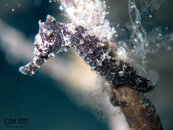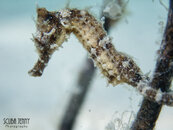tarponchik
Contributor
I posted a picture of this eel here several years ago for ID. Honestly, I do not remember the results. Most likely, this is Shrimp Eel, Ophichthus gomesii, although this species is not listed in the Blue Heron Bridge database.Happy to make it back to the bridge today after some time out of the water. We were hesitant after reading many of the recent reports, but pleasantly surprised to see a good 20-25 ft viz. Still lots of stringy stuff floating around in the water. Actually felt a bit slippery/slimy getting out of the suit! Yuk. Also quite a few moon jellies. Stay away folks, it's still not safe!! (and easier for us to find parking with less cars there
A few screen shots from Nathalie's photos.
Very shy sooty eel (thanks pipehorse) in a sandy mound ... quite the snout! Bad photo, but he was quick to retreat.
Hadn't seen one of these before.
View attachment 748470
A few of the regulars: Upside down jelly, shy jaw fish, blue throat pike blenny, sea horse.
PS: I found the photo:








